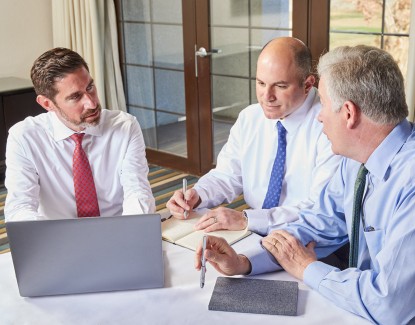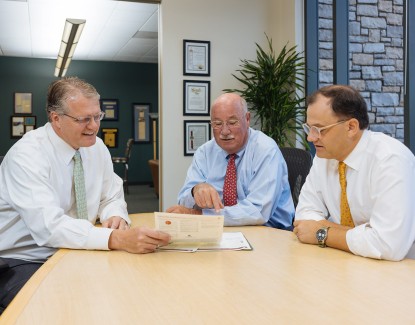The Investment Case for AST SpaceMobile
In their Quarterly Portfolio Update, the Portfolio Managers discuss the investment case for their new position in AST SpaceMobile - which they believe presents a very compelling risk-return profile.
-
 David Rainey, CFACo-Portfolio Manager
David Rainey, CFACo-Portfolio Manager -
 Brian Macauley, CFACo-Portfolio Manager
Brian Macauley, CFACo-Portfolio Manager -
 Ira Rothberg, CFACo-Portfolio Manager
Ira Rothberg, CFACo-Portfolio Manager
Portfolio Update
During the quarter we added a new 1% position in AST SpaceMobile (“AST”). This is a “special situation” investment for us, not meeting our typical compounder criteria, but we believe it presents a very compelling risk-return profile. We have been an investor in American Tower (“AMT”), a leading cell phone tower owner-operator, for more than two decades. Our investment in AST is an outgrowth of our industry knowledge and ongoing research related to AMT, as explained further below.
Today’s mobile wireless networks, built primarily on a backbone of cell towers, cover about 30% of earth’s land area (and just 10% of earth’s surface area including oceans). Since most of the world’s population lives in cities, this geographic coverage is sufficient to provide mobile service to most subscribers most of the time. However, outside of well-traveled areas, coverage becomes considerably less reliable. As a result, nearly all 5 billion global mobile wireless subscribers experience coverage gaps some of the time, and more than 1 billion potential subscribers have no mobile wireless coverage at all.
It is uneconomic to expand coverage to less densely populated areas using traditional cell towers. One promising solution, that has never fulfilled its promise, is to use satellite-based mobile phone service to fill the coverage gaps. Over the last quarter century, Iridium, Globalstar, ICO, and Teledesic have all tried, but failed to provide a viable mobile satellite solution with broad consumer appeal. We have had a front row seat to each of these endeavors, researching them but ultimately passing on investment
due to deficiencies we saw in their economic models, technology, or functionality. All these businesses eventually went bankrupt (liquidation or restructuring), incinerating billions of investor capital along the way.
More recently, a new company, AST SpaceMobile, has emerged with a fundamentally different approach from these failed ventures. AST came to our attention early this year with its SPAC merger, and a strategic private investment in public equity (PIPE) by AMT. We never expected to find opportunity via a SPAC, but AMT management, in our experience, has been exceptional at identifying the flaws in emerging wireless technologies, so their decision to invest in AST made us take notice.
Satellite delivered mobile wireless service does exist today, but, among other shortcomings, it requires bulky and expensive “satphones,” limiting adoption to relatively few use cases (commercial shipping, oil and gas drilling / platforms, extreme wilderness adventures, etc.). AST’s vision is to be able to provide mobile broadband wireless coverage anywhere on earth, using existing handheld mobile phones. This hardware compatibility would be a key breakthrough, allowing satellite delivered mobile wireless service to expand beyond niche applications to broad consumer use. AST plans to accomplish this using a proprietary software stack, a network of wireless carrier partners sharing their spectrum, and a constellation of 168 satellites placed in low earth orbit (LEO)—about 700 km above the earth—over the next several years.
Just as important, AST plans to provide this service on a wholesale basis to wireless carriers. In exchange for a 50/50 revenue split, these carriers will promote the service to their existing subscribers, and manage billing, customer service, and network integration, among other things. For carriers, benefits include incremental revenue, a better and more reliable network to reduce customer churn, and help meeting government requirements to bring connectivity to people in remote areas. For AST, this wholesale model should simplify its business plan, accelerate user adoption, and facilitate a high margin business at scale.
There are numerous technical, regulatory, and business hurdles to making AST’s vision a reality. However, our research, including conversations with industry consultants, scientists, competitors, management, and a strategic investor, have convinced us that the company has already made substantial progress—including successful demonstrations of several key technical capabilities —and that remaining hurdles are challenging, but probably surmountable.
Supporting this view, we believe that AST founder, Chairman, and CEO, Abel Avellan, has assembled a first-rate space and wireless technical team, paired with strong commercial talent. In addition, beyond AMT, wireless heavyweights Vodafone, Samsung, and Rakuten are investors and board members, and key carriage contracts or memorandums of understanding (MOUs) are in place with AT&T, Vodafone, Telefonica and other large wireless carriers representing more than 1.4 billion subscribers.
The next major technical milestone for AST will be the launch of its BlueWalker 3 satellite in late 2021 or early 2022. BlueWalker 3 will be a fully functional but scaled down version of AST’s future full-sized production satellites. This launch will build upon AST’s BlueWalker 1 trial in 2019, and allow the company to test, among other things, the unfurling of its large solar panels and beamforming capability for efficient communication with earth.
If BlueWalker 3 goes according to plan, AST will move toward Phase 1 commercialization. Importantly, following the SPAC combination and PIPE offering, AST is fully funded to build and launch its first twenty BlueBird production satellites. These satellites, scheduled to launch in late 2022 or early 2023, will provide coverage to 49 Equatorial countries covering 1.6 billion people. Assuming reasonable adoption rates, Phase 1 alone should allow AST to scale to profitability with healthy cash flow (excluding additional launches).
Plans for Phase 2 and Phase 3 include the construction and launch of 90 additional BlueBird satellites. This will require an estimated $1.7 billion of new external capital, raised opportunistically in 2022 or 2023 through a combination of vendor financing, government support, term debt, and public or private equity. With 110 total BlueBird satellites orbiting by late 2023 or early 2024, the company should be able to offer continuous global broadband coverage to all their wholesale partners. In Phase 4, plans call for internally funding an additional 58 satellites that will allow for more capacity and faster speeds in late 2024 or 2025. There are sure to be setbacks along the way, and these plans will evolve, but in broad strokes this is AST’s vision for bringing its solution to the worldwide market.
AST is attempting to solve a huge, global need. If AST can deliver this technology, modest assumptions about user adoption and ARPU tell us the company could be worth 15x or 30x more in five- or ten-years’ time. But space is hard, and the risks are real. If AST cannot deliver, the equity will likely be worthless. We recognize the potential for complete loss, and have sized our investment accordingly. But our long industry history, and network of contacts have helped us form a view that this is a bet worth making.
Additionally, as part of our research process, we have assessed the impact that a successful AST could have on cell towers and our investment in AMT. Our view is that AST’s service will be complementary to traditional cell towers, and poses no meaningful threat. While AST should offer a good in-fill option in the developed world and a low-cost primary solution for parts of emerging markets, at an estimated 30 megabits (Mbps) and 20-40 milliseconds of delay, AST will not have the capacity, speed, or latency to compete head-to-head with modern terrestrial networks.
Click here for a full listing of Holdings.
Click here for full, standardized Fund performance.
- In this article:
- Domestic Equity
- Focus Fund
You might also like
-
 Portfolio Perspective
Portfolio Perspective
Focus FundFrom Rate Cuts to AI: Positioning the Portfolio for Potential Opportunity
 David Rainey, CFACo-Portfolio Manager
David Rainey, CFACo-Portfolio Manager Ira Rothberg, CFACo-Portfolio Manager
Ira Rothberg, CFACo-Portfolio Manager Brian Macauley, CFACo-Portfolio ManagerRead the Commentary
Brian Macauley, CFACo-Portfolio ManagerRead the CommentaryThe Portfolio Managers discuss holdings that could potentially benefit from lower rates, tariffs, and artificial intelligence (AI). The team also provides an update on AST SpaceMobile and discusses potential opportunities in select Technology and Health Care companies.
-
 Company Spotlight
Company Spotlight
Focus FundO’Reilly Automotive—Revved for Growth
 David Rainey, CFACo-Portfolio Manager
David Rainey, CFACo-Portfolio Manager Ira Rothberg, CFACo-Portfolio Manager
Ira Rothberg, CFACo-Portfolio Manager Brian Macauley, CFACo-Portfolio ManagerRead the Spotlight
Brian Macauley, CFACo-Portfolio ManagerRead the SpotlightO’Reilly Automotive is a leader in the automotive aftermarket parts industry in the U.S. The company’s scale, unique distribution infrastructure, and customer service-oriented culture should allow it to take market share in a fragmented U.S. market for years to come.
-
 Portfolio Perspective
Portfolio Perspective
Cornerstone Mid Cap 30 FundPortfolio Drivers: Consumer Discretionary and Industrials
 Neil J. HennessyChief Market Strategist and Portfolio Manager
Neil J. HennessyChief Market Strategist and Portfolio Manager Ryan C. Kelley, CFAChief Investment Officer and Portfolio Manager
Ryan C. Kelley, CFAChief Investment Officer and Portfolio Manager L. Joshua Wein, CAIAPortfolio ManagerRead the Commentary
L. Joshua Wein, CAIAPortfolio ManagerRead the CommentaryCornerstone Mid Cap 30 Fund Portfolio Managers Ryan Kelley and Josh Wein review the Fund’s investment strategy, discuss the most recent rebalance, and highlight the recent change in market cap range of potential investments.
